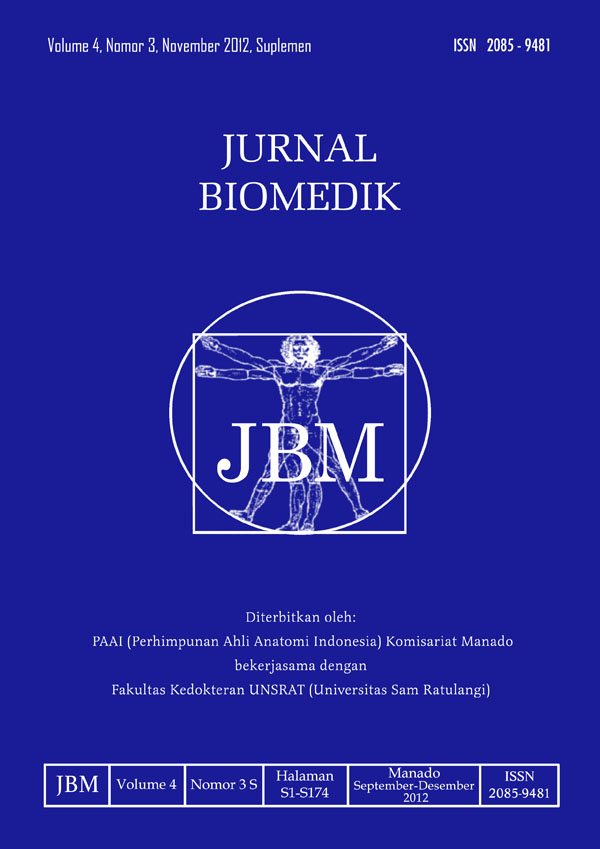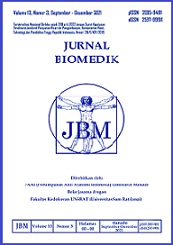PERAN SEL NODUS SINOATRIAL SEBAGAI PENGATUR IRAMA JANTUNG
DOI:
https://doi.org/10.35790/jbm.4.3.2012.1212Abstract
Abstract: The heart has a special system that provokes impulses and conducts these in the whole heart, resulting in a contraction. Normally, the sinoatrial node (SA-node) functions as a natural pace maker of the heart which plays a very important role in heart beat regulation. In the SA-node, there are two kinds of cells: P cell, a specialized nodal cell; and T cell, the transition cell. The P cell, the main SA-nodal cell, is a small cell and contains a small amount of sarcoplasma reticulum, mitochondria, and myofilaments. The T cell has a larger size, and contains more mitochondria than the P cell. The action potential in the SA-node begins in the middle of the node (P cells), spreads to the periphery (T cells), and then gets into the atrial muscle tissues. P cells provoke a slower and lower action potential than that of atrial muscles and their surroundings; meanwhile the T cells provoke a faster and larger action potential. In the P cells, the upstroke action potential occurs slowly since these cells contain a small number of Na+ channels, or none. Although Ca2+ L-type channels are responsible for the upstroke action potential in the P cells, the Na+ channels in the T cells still play some important roles.
Keywords: sinoatrial node, P cell, T cell, ion channels.
Â
Â
Abstrak: Jantung dilengkapi dengan suatu sistem khusus untuk membangkitkan impuls-impuls dan menghantarkannya dengan cepat ke seluruh jantung sehingga terjadi kontraksi otot jantung. Dalam keadaan normal, nodus sinoatrial (SA) di atrium kanan berperan sebagai pacu alami jantung dan berperan penting dalam mengatur irama jantung. Pada nodus SA terdapat sel P (sel-sel khas nodal) dan sel T (sel transisi). Sel P merupakan sel utama dalam nodus sinoatrial, berukuran kecil, dan hanya mengandung sedikit retikulum sarkoplasma, mitokondria dan miofilamen. Sel T berukuran lebih besar dan mempunyai mitokondria yang lebih banyak dari pada sel P. Potensial aksi pada nodus SA dimulai di daerah tengah nodus SA (sel P), kemudian merambat ke daerah tepi (sel T), lalu masuk ke dalam jaringan otot atrium. Sel P menimbulkan potensial aksi yang lebih lambat dan kecil dibandingkan potensial aksi pada otot atrium dan sekitarnya, sedangkan pada sel T ditemukan potensial aksi yang lebih cepat dan lebih besar. Pada sel P, potensial aksi upstroke (depolarisasi) terjadi lambat karena sel ini hanya mengandung sedikit saluran Na+, bahkan biasanya tidak ada. Meskipun saluran Ca2+ L-type (tipe lambat) yang bertanggung jawab dalam potensial aksi upstroke pada sel P, pada sel T saluran Na+ tetap berperan penting.13
Kata kunci: nodus sinoatrial, sel P, sel T, saluran ion.
Downloads
Issue
Section
License
Penyunting menerima sumbangan tulisan yang BELUM PERNAH diterbitkan dalam media lain. Naskah yang masuk dievaluasi dan disunting keseragaman format istilah dan cara penulisan sesuai dengan format penulisan yang terlampir dalam jurnal ini.
Segala isi dan permasalahan mengenai tulisan yang yang diterbitkan dalam jurnal menjadi tanggung jawab penuh dari penulis.







